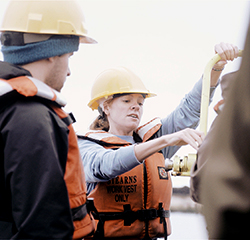Cass, an assistant professor at HSU, is currently wrapping up a project on the seasonal trends of zooplankton energy content off the Humboldt County coast, and what they mean for the salmon fishery. Her research was funded with a 2013 California Sea Grant Special Focus Award.
Zooplankton—a catchall term for the tiny animals that drift in ocean currents—are a key food source for salmon. Zooplankton nutritional value can change by species, season and lipid (oil and fat) content, with potentially big impacts for salmon fisheries. Tracking these variations happens to be Cass’s specialty.

Follow this link to sit in on one Professor Christine Cass’ class sessions on board the Coral Sea.
“During my Ph.D. in Florida, I studied a tropical copepod that had a lot of fat reserves – an unusually high level for a warm water species,” says Cass. “What I found out about them didn’t fit a lot of the assumptions about zooplankton that had already been published, so that got me interested in investigating the species off of Humboldt.”
Cass also looked at the food chain 400 km (250 miles) up the coast at NOAA’s Northwest Fisheries Science Center in Newport, Oregon. The center has nearly two decades of continuous data on zooplankton trends in the California Current, thanks to biweekly sampling beginning in 1996. In Trinidad, the Pacific Coast Ocean Observing System had been sampling since 2006. These zooplankton samples are used along with a suite of biological indicators to predict returning salmon runs, and were the basis for Cass’s study.
“Most northern animal species have higher fat content than southern species,” explains Cass. “So there was an idea that the northern species of zooplankton off of Newport were providing a great food source for salmon. Here in Humboldt, we get more of a mix of southern and northern species.”
To understand what the coastal food chain was like off Humboldt, Cass analyzed samples from the two locations to check for the species present and their lipid content. Working with zooplankton is more complicated than it sounds. Dozens might be needed to run a single sample, and Cass’s laboratory scale – able to weigh a single krill down to one 10-millionth of a gram – was so sensitive that it required a massive marble table to mute vibrations from the laboratory.
Cass ultimately found that, although they live in the same current, salmon in Trinidad swim out to a different ocean than the salmon of Newport. Zooplankton off of Trinidad often had less fat than their counterparts off of Newport. Also, Humboldt appears to be a complicated mixing zone for zooplankton, with no predictable pattern for whether northern or southern species will be fattier (and tastier) for salmon.
As Cass prepares her results for publication, she has also set her sights on a new mystery. “I’ll be starting some work to explore more bulk energy content of the zooplankton community, instead of picking particular species,” says Cass. “This will allow us to see how the energy available by the whole community changes over time.
“It’s also substantially more straightforward than live-sorting microscopic organisms to the species level,” she says.
Meanwhile, Cass shares her passion with the next generation of marine scientists. She says that, although copepods and krill may be tiny, “Students don’t usually need too much convincing to study zooplankton.”
“Most people go in to marine biology thinking they’ll study marine mammals, but mammals are a very small percentage of all the animals out there,” says Cass. “They see how important the little things are to the oceans and are ready to learn about how it works.
“Even blue whales eat the zooplankton.”